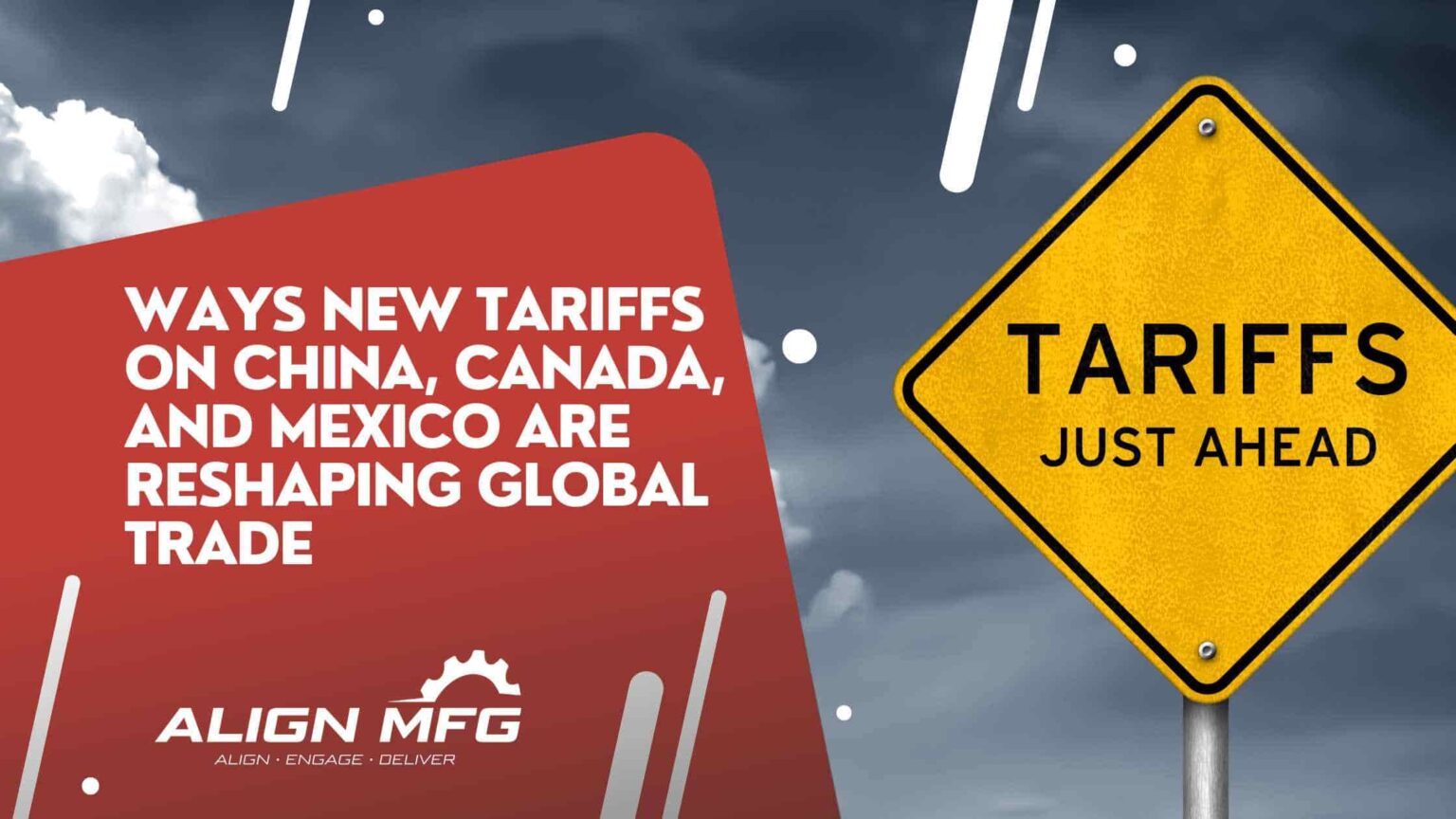
Ways New Tariffs on China, Canada, and Mexico Are Reshaping Global Trade
In March 2025, the US implemented sweeping tariffs on imports from China, Canada, and Mexico, escalating trade tensions and reshaping global supply chains. The US imposed a cumulative 45% tariff on Chinese goods (25% from Section 301 tariffs, plus 10% in February 2025, and another 10% in March 2025). Additionally, 25% tariffs on Canadian and Mexican imports have come into effect, targeting key sectors like steel, aluminum, and agricultural products. These measures have triggered immediate retaliatory actions, with Canada announcing 25% tariffs on $155 billion worth of US goods and China targeting US agricultural products with 10%-15% tariffs. This article explores the impact of these newly imposed tariffs, the global response, and how Align Manufacturing, your partner in precision engineering and sourcing excellence, can help businesses diversify their supply chains to mitigate rising costs and geopolitical risks.
The New Tariffs: What’s Changed in March 2025?
The US has cumulatively increased tariffs on Chinese goods to 45%, combining the existing 25% Section 301 tariffs with an additional 10% in February 2025 and another 10% in March 2025. This applies to a wide range of goods, including electronics, machinery, and consumer products. For Canada and Mexico, the US has imposed 25% tariffs on key exports, though steel and aluminum products are subject to Section 232 tariffs, which apply to all countries and target specific steel mill products like I-beams, rebar, and extrusions.
Key Changes:
- China Tariffs: Cumulative 45% tariff now applies (25% Section 301 + 10% February + 10% March).
- Canada and Mexico Tariffs: 25% tariffs on a broad range of goods, with steel and aluminum subject to Section 232 tariffs.
- Retaliatory Measures: Canada and China have announced immediate counter-tariffs, while Mexico is expected to unveil its response soon.
Immediate Impact on Global Trade
The new tariffs have already disrupted global trade, with countries like Canada and China retaliating swiftly. Canada imposed 25% tariffs on $155 billion worth of US goods, targeting agricultural products and energy exports, but retaliatory hikes in Tariffs are simply being matched by the US seeing tariffs increase further. China, meanwhile, has slapped 10%-15% tariffs on US agricultural goods, including soybeans, pork, and dairy.
Key Impacts:
- Higher Costs for Consumers: Tariffs are expected to increase prices for essential goods like food, fuel, and electronics.
- Supply Chain Disruptions: Companies relying on cross-border trade between the US, Canada, and Mexico face higher costs and logistical challenges.
- Economic Uncertainty: The tariffs have created volatility in global markets, with Asian stock indices like Japan’s Nikkei 225 dropping sharply.
Long-Term Adjustments in Global Supply Chains
The tariffs are forcing businesses to rethink their supply chain strategies. Many companies are exploring alternative manufacturing hubs in Southeast Asia, such as Thailand, Vietnam, and India, to avoid rising costs and geopolitical risks.
Why Diversify?
- Cost Efficiency: Moving production to countries with lower tariffs and labor costs can offset the impact of US trade policies.
- Risk Mitigation: Diversifying supply chains reduces dependency on a single region, making businesses more resilient to geopolitical risks.
- Access to New Markets: Manufacturing in Southeast Asia provides easier access to emerging markets in the region.
Key Import Categories Affected by New Tariffs
As businesses adapt to the new tariff landscape, understanding which import categories are most affected is crucial for strategic supply chain planning. Recent data from the US Census Bureau reveals the countries most impacted across major product categories:
Mexico faces the highest exposure in:
- Delivery trucks (78% of US imports)
- Insulated wire (53%)
- Computers (34%)
China dominates US imports of:
- Electric batteries (56%)
- Telephones (45%)
Canada is the primary source for:
- Crude petroleum (58%)
- Refined petroleum (22%)
These figures highlight why many US manufacturers are urgently reevaluating their supply chains. For instance, automotive and electronics manufacturers face significant cost increases with Mexico and China tariffs affecting crucial components. Meanwhile, energy-intensive industries must navigate higher costs due to Canadian petroleum tariffs.
The diversification trend is accelerating as businesses seek to reduce dependency on these heavily taxed import channels. Companies importing delivery trucks from Mexico, for example, are now exploring alternatives in Southeast Asia and India where tariff exposure is minimal. Similarly, electronics manufacturers dependent on Chinese batteries and telecommunications equipment are establishing new supplier relationships in Vietnam and Thailand.
This strategic pivot isn’t merely about avoiding tariffs—it’s about creating resilient supply chains that can withstand future trade policy shifts. Forward-thinking businesses are treating this disruption as an opportunity to build more agile, diversified supplier networks that reduce concentration risk while potentially opening doors to new markets.
4. The Role of Align Manufacturing in Supply Chain Diversification
Align Manufacturing specializes in helping companies transition their manufacturing operations from China, Canada, and Mexico to alternative locations like Thailand, Vietnam, and India. By leveraging local expertise, infrastructure, and trade agreements, AlignMFG ensures a seamless transition that minimizes supply chain disruption and maximizes cost savings.
Services Offered:
- Site Selection: Identifying the best locations for manufacturing based on industry-specific needs.
- Logistics Optimization: Streamlining supply chain operations to reduce costs and improve efficiency.
- Regulatory Compliance: Navigating local laws and trade agreements to ensure smooth operations.
5. Case Study: Success Stories in Supply Chain Diversification
Several companies have successfully diversified their supply chains with Align Manufacturing’s assistance. For example, a US-based electronics manufacturer relocated its production to Vietnam, reducing costs by 25% and avoiding tariffs on Chinese imports. Another client, a furniture retailer, moved operations to India, benefiting from lower labor costs and access to a growing domestic market.
The Future of Global Trade
As tariffs continue to reshape global trade, businesses must adapt to remain competitive. Diversifying supply chains is no longer optional but a strategic necessity. By partnering with Align Manufacturing, companies can navigate this transition effectively, ensuring long-term growth and resilience.
Summary
The newly imposed tariffs in March 2025 are creating significant challenges for businesses worldwide. However, these challenges also present opportunities for companies willing to adapt. By diversifying supply chains to regions like Thailand, Vietnam, and India, businesses can mitigate the impact of tariffs and maintain cost efficiency. AlignMFG is your trusted partner in this journey, offering the expertise and support needed to make this transition seamless and successful.
Ready to Diversify Your Supply Chain? Contact Align Manufacturing today to explore how we can help your business thrive in a changing global landscape.
NOTE: With retaliatory tariffs being a regular occurance be sure to contact us about your manufacturing projects for up to date info on tariffs and expert guidance on reducing your supply chain risk.
FAQs
How long does it take to relocate manufacturing operations?
The timeline varies depending on the complexity of the operation, but Align Manufacturing typically completes transitions within 6-12 months.
What industries benefit most from diversification?
Industries like electronics, textiles, furniture, and automotive are particularly well-suited for diversification due to their reliance on cost-effective manufacturing.
How does AlignMFG ensure a smooth transition?
Align MFG provides end-to-end support, from site selection and logistics to regulatory compliance and workforce training.

